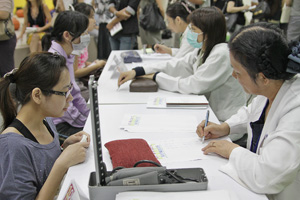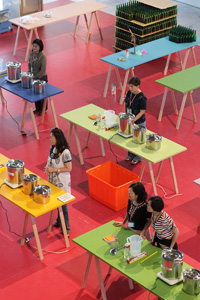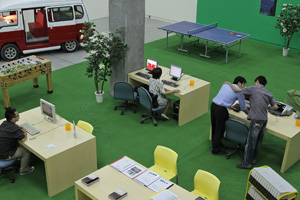TB10 endeavors to unmask the political in art
By Eva Tang This year’s Taipei Biennial is all about introspection. It has no specific name and focuses on the politics of art. It examines the meaning of ‘biennial’ itself by innovating the way to make an exhibition. Twenty-four artists from around the world are showing 38 works at TB10, a smaller exhibition compared to biennials in general, to encourage the audience to spend more time on each work. A typical biennial no longer interests the curators Tirdad Zolghadr and Lin Hong-john, who were appointed last December, so together they organized TB10 in seven months. “We all agree they are too big, too short-term and too sensational. Artists have to compete with each other. Audiences see 500 works in 2 hours without understanding the art, and art itself becomes one little thing in a big monster of a machine.” Lin thinks that a biennial has morphed into a deformed art fair where political art prevails, so he now wants to show the politics that is found in art. “Political art stays in the museums and doesn’t make actual changes. It has become something trendy. And a lot of times biennial is used as a tool to file a petition, or do urban marketing,” he explained. “We want to mark the politics of TB10. We want to talk about the political issues we face appreciating the arts.” Thus most of the works the curators chose to show are not single objects that the artist can sell after the biennial. Many of the artists don’t maintain a business relationship with commercial galleries or institutions. Lin exemplified Allan Sekula’s “School is a Factory” and Mario Garcia Torres’ “Who Killed Robert’s Secret? A Class Portrait” as illustrations of how art is produced, art education and its relationship with the cultural policies of a country. Sekula developed the work when he experimented on a variety of media from slide show to photo-novellas, in his days as a school lecturer. Garcia Torres expanded a student project in an art school in Canada in 1969. In that project, three students were asked to share a secret, and this became the art work itself. Once the secret was out, the artwork ceased to exist. Garcia Torres made an installation that included the initial form of the art piece, the works of the three students, and slideshows to tell visitors the story. More than static exhibits Entering the hall of TFAM on the ground floor, it feels like entering a cooking class or some kind of workshop, because you see boilers, electric stoves, and measuring cups on the table, while instructors stand in front to guide the participants. This is actually Superflex the Free Beer Factory, a group of artists applying the principles of ‘creative commons’ to brewery. In Taipei Biennial 2008 Superflex worked with North Taiwan Brewing to produce ‘Free Beer Taiwan’. As for TB10, the manufacturing process as well as the machines and tools become a part of the display. And ‘Free Beer’ is provided for seminars and workshops at TB10. Pak’s other work in the TB10 is “Going Home Projects”, in which he accompanies one visitor home everyday, and documents the journey in a blog. Standing next to his signboard saying “Let the artist go home with you”, Pak looks all friendly in his white t-shirt. Whether the visitor lives in Taipei or Kaohsiung, Pak is willing to go with them as long as they agree. Log on www.oneeyeman.blogspot.com to learn more about his adventures. Most major exhibitions provide the service of an audio guide, TB10 is no exception. Visitors even have two options. One of them is Chang Yun-han’s work “If You Take it Seriously”; only the visitor may not discover it is a part of the show. In the audio guide, Chang designed an interesting dialogue between two people discussing the exhibits from the general public’s point of view, so unlike audio guides which usually speak to the listener in a more instructional way. Through her work, Chang guides the audience to think about the social and cultural context of an art museum and art exhibitions. Of course, if visitors prefer the typical audio guide, it is also available at the museum’s information counter. Dare to challenge Among the exhibits at TB10, twenty were especially commissioned for the show, while some of the artists who joined TB08 were invited to critique their previous contributions. Olivia Plender built a “Google Office” that included a meeting room, an events room equipped with “discussion islands”, a waiting room, a game room and more, like the Google Inc. office in London. Her installation hosts both planned and held impromptu activities, representing present-day offices. The work is carried out with several local actors and actresses who take shifts to perform in the version 0.2 office, where you see people queuing to enter. Don’t hesitate to get in line. This is one of the works you have to experience on your own. Portnoy also organized the Taipei Women’s Experimental Comedy Club with local performers and presented a series of stand-up comedy shows at TB10’s opening on Sept.7. A stand-up comedian himself, Portnoy is intrigued by the role models in women’s stand-up comedy back in the late 1970s. Thus the performances are based on his research and contemporary humor theory. When Christian Jankowski learned that the appointment of a new director for TFAM had been postponed for 6 months, he thought of recruiting a new one for them. The outcome was the “Director’s Cut.” Jankowski posted job recruitment ads, invited judges and made an actual audition for those who signed up for the position. During the audition, the applicants announced their viewpoints and vision on how to manage TFAM. The judges threw quick questions at them and judged their responses. After editing, the film “Director’s Cut” ended up about 30 minutes long and displayed in the director’s office. Two-year plan To make TB10 more than just a biennial, the curators have mapped out a two-year collaboration project with local cultural and art venues, to interact with the city and engage its people. For example, artist Yao Jui-chung and Lost Society Documenta (LSD) have been doing surveys on public space that is left unused after elections. A lot of them are cultural venues and they named such facilities ‘Mosquito Museums’. Yao and LSD released their report with photographs in the TFAM Google Office on Sept.17. All the participating artists of TB10 will develop a new work to display in 2012, one of the ways to continue the life of a biennial. “We hope that through this, the biennial becomes less of just a token, and is a reflection of the interaction between the local and the global art circles,” said Lin. “It is good to have a revolution.” TB10 runs through November 14. Entrance is free. Log on http://www.taipeibiennial.org/web_TB_2010/en/index.html for more information.
Staff Reporter
Photos by Rick Yi, Taiwan News “Hong-john and I have seen many biennials, and we talked to the artists. Nobody is happy about biennials,” said Zolghadr during an interview on September 8, a day after TB10 was unveiled.
“Hong-john and I have seen many biennials, and we talked to the artists. Nobody is happy about biennials,” said Zolghadr during an interview on September 8, a day after TB10 was unveiled. As you walk further in, there’s a row of lockers which is great if you have something you don’t want to carry into the exhibition. Frequent museum goers may wonder when the museum started to provide such a service. That’s a possible moment to discover the fact that the locker is an exhibit of TB10, by Pak Sheung-chuen. Don’t worry, the lockers are usable for NT$10 each time. Who says art is not practical!
As you walk further in, there’s a row of lockers which is great if you have something you don’t want to carry into the exhibition. Frequent museum goers may wonder when the museum started to provide such a service. That’s a possible moment to discover the fact that the locker is an exhibit of TB10, by Pak Sheung-chuen. Don’t worry, the lockers are usable for NT$10 each time. Who says art is not practical! Don’t miss the Google Office 0.2 when you finish playing the games in Plender’s Google Office. It is The Improvement League’s work led by Michael Portnoy. The League was established to improve existing artworks by adjusting certain traces of thoughts by way of experiments. Their first target is Plender’s Google Office.
Don’t miss the Google Office 0.2 when you finish playing the games in Plender’s Google Office. It is The Improvement League’s work led by Michael Portnoy. The League was established to improve existing artworks by adjusting certain traces of thoughts by way of experiments. Their first target is Plender’s Google Office.

![Taiwan.gov.tw [ open a new window]](/images/egov.png)
